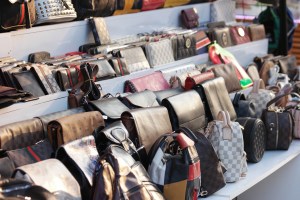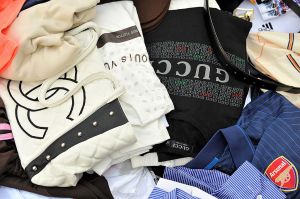Luxury’s counterfeiting problem just keeps getting worse.
In Entrupy’s 2024 edition of its annual State of the Fake report, the company revealed that it had authenticated more than $1.48 billion worth of products in 2023 with almost 9 percent of all items found as unidentified (or not found to be authentic), an increase of 0.8 percent year-over-year. It’s unsettling — especially as it signifies an increase in filtering into legitimate businesses.
In its partnership with brands and retailers, Entrupy’s AI technology revealed luxury brands with the most authentications in 2023 to be Louis Vuitton (32 percent), Chanel (13 percent) and Gucci (13 percent), followed by Prada (10 percent) and Coach (5 percent). Brands with the highest unidentified rates in 2023 were Goyard (increased 23 percent), Prada (14 percent), Celine (12 percent), Hermès (12 percent) and Loewe (11 percent).
You May Also Like
The “most unidentified material” was the Goyardine canvas with the Goyard St. Louis Tote being found as the “most unidentified style.” Prada’s nylon was also often found as unidentifiable with the Re-edition 2000 ranking as the brand’s most unidentified style.
“While the acceptability of dupes might be on the rise, having an on-demand, on-premise authentication solution is a huge deterrent for most consumers looking to hoodwink someone,” Vidyuth Srinivasan, chief executive officer of Entrupy. “I’d like to believe that we play a part in that. Our work now includes expanding our distribution globally and enabling support for more products and categories at large. As we scale, our core mission of providing the most accurate result in the quickest way possible doesn’t change.”
Looking at the current trends in counterfeiting, Entrupy’s report points out that counterfeiting is a global problem, one with high costs not only to the replicated brands but to the environment, economies and quality of life. According to the company’s findings, counterfeit goods are not 3.3 percent of global trade and are just one part of the IP theft problem that costs the global economy.

Counterfeit handbags at an outdoor marketplace.
DenisProduction.com – stock.adobe.com
“While many people might think it’s no big deal to buy a counterfeit product, it actually is going beyond just hurting the brand, the environmental impact and the production standards,” Srinivasan said. “The product can be harmful to your health. In 2022, the American Apparel and Footwear Association found that 36 percent of tested counterfeit clothing and footwear contained dangerous levels of arsenic, cadmium, phthalates and lead. These harmful chemicals can lead to various health issues, including skin irritations and long-term health effects.”
Factors that are intensifying the counterfeiting problem today include an evolution of counterfeit listings, the rise of social media as a marketplace, increased use of technology in counterfeiting and the growth of counterfeit marketplaces. Counterfeiting businesses have become aware of some of the easier ways for legitimate brands to find fakes online and have become careful not to use branded product names, trademarks and key phrases while also carefully selecting product images that do not belong to the brand.
On social media, counterfeiters have started using popular creators to sell products, finding the influence of these sellers to be significant. Entrupy’s report calls out the creation of the hashtag #RepTok (or replica-tok), which tags counterfeit goods even though it is against TikTok’s policy on counterfeit goods. Other technologies being used to increase counterfeit sales online include fake reviews, AI-generated images and virtual influencers.
While Srinivasan told WWD that it is hard to comment on the intentions of others, he said “it is possible that the increased acceptance of fakes has encouraged social media creators to harness the attention/controversy it brings.”
While ultimately, he said, “It is unknown if the sellers know that they are encouraging a crime in selling counterfeit products, or if they know the effect counterfeit items have on the environment and beyond, it is interesting that counterfeit sellers spend time in multiple forums soliciting feedback on the quality of their products. It wouldn’t be that surprising to see them find ways to market their products through endorsements with social media creators.”
In addition to an increase of counterfeit sales across social media platforms, Entrupy said there has been a notable growth in counterfeit marketplaces including DHgate, which has become known for counterfeiting “luxury dupes” and Shopee, which has been flagged by the U.S. government as a “notorious market for counterfeiting and piracy.”
“Globally, with the explosion of live shopping, large-scale digital marketplaces and more efficient trans-national wholesaling, we are seeing an increase in counterfeits specifically among pawn networks, with their unidentified rates going up an alarming 2 percent,” Srinivasan said. “However, the numbers across have been stable and even reducing reasonably among all other business types, validating the work we’re doing as an industry to deter counterfeit sales.”

Counterfeits seized by customs in Europe.
Getty Images
In the U.S., Entrupy finds that a significant portion of counterfeit items originate from China with 66 percent of seized IP-infringing items found by U.S. customers and border protection coming from China in 2023. Twenty-six percent of items seized were in the apparel category (total retail value of $451 million), 24 percent were handbags and wallets (total retail value of $659 million) and 12 percent were footwear (total retail value of $61 million). The final 16 percent of items seized were fake versions of high-end watches and jewelry with a total retail value of $1.061 billion.
Notably, some brands continue to hold out on working with an authentication technology solution like Entrupy. Srinivasan told WWD that in general, he has seen that brands do not want to talk about the issue of counterfeiting as it doesn’t gel well with their aspirational marketing. He hopes that reports and data like the State of the Fake report will be “a great opportunity for them to educate consumers on the issues behind counterfeit products and shed light on solutions, like Entrupy, and resellers, whose mission is to protect consumers and businesses from purchasing counterfeit items rather than listen to those who are telling them to encourage such shopping behavior.”
To fight the global counterfeiting problem, Entrupy’s experts said many courses of action need to be taken including lobbying for stronger laws, enforcement strategies and mandatory and comprehensive authentication and traceability processes. Additionally, the company encouraged the industry to look to consumer behavior to decode the true drivers of counterfeit purchases. Financial savings are certainly a key motivator for counterfeit purchases, meaning brands must “highlight the psychological rewards of avoiding counterfeits.”
This post was originally published on this site be sure to check out more of their content.








